Android basics – Key Codes – ADB – Rooting Android – Boot Process – File Systems – Security – Tools – Android Forensics – Forensic Procedures – ADB – Android Only Tools – Dual Use Tools – Oxygen Forensics – MobilEdit – Android App Decompiling.
- 1. Unit V ANDROID FORENSICS Android basics – Key Codes – ADB – Rooting Android – Boot Process – File Systems – Security – Tools – Android Forensics – Forensic Procedures – ADB – Android Only Tools – Dual Use Tools–Oxygen Forensics – MobilEdit – Android App Decompiling.
- 2. Android basics • Introduction • Android has a large percentage of the mobile device market, making it important for understanding mobile forensics. This knowledge must include the fundamentails of Android, including the history of the operating system. But it also includes more detailed information such as the various file systems and the system architecture. Furthermore, there are various tools for working with Android including Android Debugging Bridge (ADB).
- 3. Android basics • Android is a very common operating system. It is obviously found on Android phones, but it is also found in smart TVs, automobiles, and some IoT devices. It is clearly quite important to understand the Android operating system in some depth. The Android operating system is a Linux-based operating system, and it is com-pletely open source. If you have a programming and operating systems background, you may find it useful to examine the Android source code from http:// source.android.com/.
- 4. Android basics • Android was first released in 2003 and is the creation of Rich Miner, Andy Rubin, and Nick Sears. Google acquired Android in 2005, but still keeps the code open source. • The versions of Android have been named after sweets: • Version 1.5 Cupcake • Version 1.6 Donut • Version 2.0-2.1 Éclair • Version 2.2 Froyo • Version 2.3 Gingerbread • Version 3.1 - 3.2 Honeycomb • Version 4.0 Ice Cream Sandwich • Version 4.1 - 4.2 Jellybean • Version 4.3 Kitkat
- 5. Android basics • The versions of Android have been named after sweets: ... • Version 5.0 Lollipop released November 3, 2014 • Version 6.0 Marshmallow released October 2015 • Version 7.0 Nougat was released in August 2016 Version 8.0 Oreo released August 2017 • Version 9.0 Pie August 6, 2018 • Android 10. This was called Q during beta testing, and it marks a departure from using the names of deserts. This was released in September 2019 • Android 11 Released February 2020
- 6. Android basics • The differences from version to version usually involve adding new features, not a radical change to the operating system. This means that if you are comfortable with version 7.0 (Nougat), you will be able to do forensic examination on version 9.0 (Pie). While the Android source code is open source, each vendor may make modifications. This means even the partition layout can vary. However, there are common partitions that are present on most Android devices (phones or tablets).
- 7. Android basics • The boot loader partition is necessary for hardware initialization and loading the Android kernel. This is unlikely to have forensically important data. The boot partition has the information needed to bootup. Again, this is unlikely to have forensically important data. The recovery partition is used to boot the phone into a recovery console. While the partition may not have forensically relevant data, sometimes you may need to boot into recovery mode.
- 8. Android basics • The userdata partition is the one most relevant to forensic investigations. Here you will find the majority of user data including all the data for apps. We will discuss SQLite databases in chapter 8, this directory will contain many of those database. The cache partition stores frequently accessed data and recovery logs. This can be very important for forensic investigations. There can be data here that the user is not even aware of. This means the user is less likely to have deleted it.
- 9. Android basics • The system partition is not usually important for forensic examinations. Remember that Android is Linux based, if you have an image of an Android phone you may be able to execute at least some Linux commands on it. For ex-ample, using cat proc/partitions will reveal to you the partitions that exist on the specific phone you are examining. • In addition to these partitions there are specific directories that may yield forensic evidence.
- 10. Android basics • The acct directory is the mount point for the control group and provides user accounting. • The cache directory stores frequently accessed data. This will almost always be interesting forensically. • The data directory has data for each app. This is clearly critical for forensic examinations. • The mnt directory is a mount point for all file systems and can indicate in-ternal and external storage such as SD cards. If you have an Android image, the Linux ls command used on this directory will show you the various storage devices.
- 11. Android basics • As you encounter dates on files in Android, there can be some confusion. Android can use several different date/time formats. The following lists the various formats available: • UNIX, based on Jan 1, 1970 • GPS, based on Jan 6, 1980 • Some (such as Motorola) may use AOL, based on Jan 1, 1980 64 An In-Depth Guide to Mobile Device Forensics
- 12. Android basics • Fortunately, there are a number of online converters for date and time formats. You can simply search for a converter, but here are a few you may find useful: https://www.unixtimestamp.com/index.php https://timestamp.online/ https://www.onlineconversion.com/date_time.ht m
- 13. SPECIALIZED KEY CODES • There are a number of keycodes that can be entered on an Android phone to get useful information from the phone. Some of these codes work with all Android models, others are specific to particular models. These are useful in diagnostics as well as forensics. • Diagnostic configuration *#9090# Battery Status *#0228# System dump mode *#9900# Testing Menu *#*#4636#*#* Display Info about device *#*#4636#*#* Factory Restore *#*#7780#*#*
- 14. SPECIALIZED KEY CODES • Camera Information *#*#34971539#*#* Completely Wipe device, install stock firmware *2767*3855# Quick GPS Test *#*#1472365#*#* Wi-Fi Mac Address *#*#232338#*#* RAM version *#*#3264#*#* Bluetooth test *#*#232331#*#* Displays IMEI number *#06# Remove Google account setting *#*#7780#*#* Toggle always-on display on or off *#99#
- 15. SPECIALIZED KEY CODES • Log test settings *#800# Engineering switch test mode *#801# GPS TTFF (Time-To-First-Fix) test mode *#802# Engineering Wi-Fi setting *#803# Automatic disconnect test mode *#804# Engineering bluetooth test mode *#805# Engineering aging test mode *#806# Engineering automatic test mode *#807#
- 16. SPECIALIZED KEY CODES • Enter engineering mic echo test mode *#809# Automatically searches for available TDSCDMA carriers *#814# Automatically searches for available WCDMA carriers *#824# Automatically searches for available LTE carriers *#834# Automatically searches for available GSM carriers *#844# Test photograph RGB (Red, Green, & Blue tint) *#900# LCD display test *#*#0*#*#** Packet loopback *#*#0283#*#* Melody test *#*#0289#*#*
- 17. SPECIALIZED KEY CODES • Proximity sensor test *#*#0588#*#* Melody test *#*#0673#*#* Test for vibration and backlight functionality *#*#0842#*#* Advanced GPS testing *#*#1575#*#* Touch screen test *#*#2664#*#* Checks for root *#*#7668#*#* Bluetooth test *#*#232331#*#*
- 18. SPECIALIZED KEY CODES • These are just a sample of codes. One can search the internet for something like “Secret codes for XXXX phones” (replacing xxxx with the model you are interested in) to get information on codes for that specific phone model.
- 19. ADB • You can download this free tool from https://developer.android.com/studio/ command- line/adb. The Android Debugging Bridge has three components: • A client, which sends commands. The client runs on the development ma-chine. The investigator can invoke a client from a command-line terminal by issuing an adb command. • • A daemon (adbd), which runs commands on a device. The daemon runs as a background process on each device. • • A server, which manages communication between the client and the daemon. The server runs as a background process on your development machine.
- 20. ABD • When you start an adb client, the client first checks whether there is an adb server process already running. If there isn't, it starts the server process. When the server starts, it binds to local TCP port 5037 and listens for commands sent from adb clients – all adb clients use port 5037 to communicate with the adb server. When a device is connected to a computer that has ADB, the first step is to list all connected devices. This is shown in Figure 4.1.
- 21. ABD
- 22. ABD • If the device does not show as attached, there are several possibilities. One common issue is that the developer mode is not turned on. Another possibility is that the ADB services has a problem. This requires you to first kill the service, then restart it as shown here: • adb kill-server • adb start-server
- 23. ABD • Once you have connected successfully to the Android device, there are several commands that are of interest when using ADB. One of the most interesting is the adb shell command. The adb shell command, enters a shell on the Android, from which the user can utilize standard Linux commands. This is shown in Figure 4.2
- 24. ABD
- 25. ABD • Common Linux commands done from within the adb shell include pstree, to list all the processes on the target device, in a tree format. Other standard Linux commands such as ps, ls, netstat, and lsof can also be useful. When you wish to exit the shell, just type exit as shown in Figure 4.3.
- 26. ABD
- 27. ABD • To see all the Linux commands available on a given device, from within the adb shell one can type ls/system/bin. This will show all the system binary files (i.e., executables). This is shown in Figure 4.4.
- 28. ABD
- 29. ABD Aside from issuing Linux commands from within the adb shell, there are also adb specific commands that can be useful in a forensic examination. Common ADB commands are summarized in Table 4.1. Note, as you have seen in the screenshots,
- 30. ABD
- 31. ABD
- 32. ABD
- 33. ABD you only have to type “adb shell” before a command if you are using a shell command and are not currently in the adb shell. These commands combined with the specialized key codes discussed earlier can provide a great deal of information about the phone in question. This table is not an exhaustive list of adb commands, but it does provide the most common adb commands.
- 34. ROOTING ANDROID Unfortunately, there is some data one cannot get to without rooting the Android phone. The term root is the Linux term for the administrator. In Linux, you simply type su (super user or switch user) and enter the root password. However, Android phones don’t allow you to do that. Rooting a phone gives you complete root access to all aspects of the phone. However, that will also void any warranty.
- 35. ROOTING ANDROID In the past, rooting was not terribly difficult. There were even apps one could get that would root the phone for you. Most of these apps do not work on current models of Android. However, there are some methods that might work, depending on a number of variables. For example, the model you have, the version of Android, etc. will affect whether or not you will be successful. It is important to keep in mind that these are simply possible techniques. There is no guaranteed method for rooting an Android phone.
- 36. ROOTING ANDROID Before you can root a phone it must first be OEM (Original Equipment Manufacturer) unlocked. And it so happens, that before you can OEM unlock, you must first unlock it from the carrier. The only consistently effective method for carrier unlocking is to contact the carrier, assuming the contract is paid off, and request a carrier unlock. After that you have several options for OEM unlock, again depending on what manufacturer and model you are working with.
- 37. ROOTING ANDROID If your phone has “OEM Unlock” enabled and visible under developer settings, then you have the option to use ADB (discussed in the previous section) and move to what is called fastboot mode. For most phones this is done by using ADB and typing in adb reboot bootloader. At that point you can try fastboot oem unlock. If that does not work, then your model requires you to get an unlock code and send it to the vendor to get OEM unlock. This is shown in Figures 4.5 through 4.7.
- 38. ROOTING ANDROID
- 39. ROOTING ANDROID
- 40. ROOTING ANDROID
- 41. ROOTING ANDROID Once the phone is OEM unlocked, you can then root the phone. But be aware, that for many phones getting to the OEM unlock might be very difficult. by typing. adb reboot bootloader followed by fastboot oem device-info You will then see the devices OEM unlock status as shown in Figure 4.8.
- 42. ROOTING ANDROID
- 43. ROOTING ANDROID Once it is OEM unlocked, you can use free tools such as Magisk to install a new image, that is rooted. Once you have installed Magisk you can update your system. But you need to push the image onto the system for Magisk to be able to find it. That can be done with adb push. Also, for new images, they take up a lot of space, make sure you have enough space for the image. The process, once you have OEM unlocked is as follows. Once you have the phone OEM-Unlocked, rooting is not that difficult.
- 44. ROOTING ANDROID You will need a TWRP image, those can be found at https://twrp.me/Devices/ • Place TWRP recovery image in “ADB and Fastboot” folder • Open fastboot • Check to make sure the device is connected with adb devices. • Reboot in boot loader mode by adb reboot bootloader • Use the phone screen to select Apply Update from ADB Sideload, or similar entry. • type fastboot flash recovery twrp.img
- 45. ROOTING ANDROID Note that the twrp.img is whatever image you intend to put on the phone, and it must be in the fastboot directory. Also keep in mind, that with newer phone models, any one of these steps may fail. Rooting modern phones is a difficult task and frequently fails.
- 46. BOOT PROCESS Every operating system has a boot process. This begins when the power is turned on and completes when the device’s operating system is fully loaded and functioning. Before the device is powered on, the device CPU will be in a state where no in-itializations have been done. Once the Android device is powered on, execution starts with the boot ROM code. This boot ROM code is specific to the CPU the device is using.
- 47. BOOT PROCESS This phase includes two steps, A and B: Step A: When the boot ROM code is executed, it initializes the device hardware and attempts to detect the boot media. Therefore, the boot ROM code scans until it finds the boot media. Step B: Once the boot sequence is established, the initial boot loader is copied to the internal RAM. After this, the execution shifts to the code loaded into RAM.
- 48. BOOT PROCESS This brings us to what is the bootloader? The bootloader is a relatively small program that is executed before the operating system starts to function. Bootloaders are present in all computing devices and used to get the system booted to the point that the operating system can be loaded. In the Android boot loader, there are two stages – Initial Program Load (IPL) and Second Program Load (SPL).
- 49. BOOT PROCESS As shown in the following screenshot, this involves the three steps explained here: • Step A: IPL deals with detecting and setting up the external RAM. • Step B: Once the external RAM is available, SPL is copied into the RAM and execution is transferred to it. SPL is responsible for loading the Android operating system. • Step C: SPL tries to look for the Linux kernel. It will load this from boot media and will copy it to the RAM. Once the boot loader is done with this process, it transfers the execution to the kernel.
- 50. BOOT PROCESS The kernel is the heart of any operating system. And for Android phones that is the Linux kernel. The Linux kernel is the heart of the Android operating system and is responsible for process management, memory management, and enforcing security on the device. Different versions of Android use different versions of the Linux kernel. The Android kernel is a variation of the Linux kernel, but is quite similar to the standard Linux kernel. This is summarized in Table 4.2.
- 51. BOOT PROCESS
- 52. BOOT PROCESS It should be noted that Android includes a number of different manufacturers. Each manufacturer may alter the Android code base, and even alter the Linux kernel used. So, Table 4.2 is just a general guideline to the kernel version used in specific Android versions.
- 53. BOOT PROCESS After the kernel is loaded, it mounts the root filesystem (rootfs) and provides access to system and user data: Step A: When the memory management units and caches have been initialized, the system can use virtual memory and launch user space processes. Step B: The kernel will look in the rootfs for the init process and launch it as the initial user space process:
- 54. BOOT PROCESS • The process rootfs is the place to start and stop searching the doubly linked list of mount points. It is a special instance of ramfs which is a simple file system used to get the system booted. • The basic initramfs is the root filesystem image used for booting the kernel provided as a compressed archive. – If an uncompressed cpio archive exists at the start of the initramfs, extract and load the microcode from it to CPU.
- 55. BOOT PROCESS – If an uncompressed cpio archive exists at the start of the initramfs, skip that and set the rest of file as the basic initramfs. Otherwise, treat the whole in-itramfs as the basic initramfs. – Unpack the basic initramfs by treating it as compressed (currently gzipped) cpio archive into a RAM-based disk. – Mount and use the RAM-based disk as the initial root filesystem.
- 56. FILE SYSTEMS File systems are how files are organized on storage devices. Whether that is a traditional hard drive, or a solid-state drive. In chapter 3 we discussed the APFS file system used with iOS devices. There are several file systems used with Android. The major file systems are listed here: • F2FS: Flash-Friendly File System • JFFS2: Journaling Flash File System version 2 • YAFFS: Yet Another Flash File System
- 57. FILE SYSTEMS F2FS: FLASH-FRIENDLY FILE SYSTEM The key data structure is the “node”. Similar to traditional file structures, F2FS has three types of nodes: inode, direct node, indirect node. F2FS assigns 4 KB to an inode block which contains 923 data block indices, two direct node pointers, two indirect node pointers, and one double indirect node pointer as described below. A direct node block contains 1018 data block indices, and an indirect node block contains 1018 node block indices. The different nodes are shown in Table 4.3.
- 58. FILE SYSTEMS
- 59. FILE SYSTEMS F2FS divides the volume into six regions. The first is the superblock (SB) which is at the beginning of the partition. There is a second copy of the superblock so that if the first becomes corrupt, the system can recover. Then there is the checkpoint (CP). This contains information about the system including entries of active seg-ments and lists of any orphaned inodes. Next comes the segment information table (SIT) which has a block count and bitmap of the main area blocks.
- 60. FILE SYSTEMS This is followed by the node address table (NAT) which contains the addresses for the nodes. That is in turn followed by the segment summary area (SSA) which contains information about who owns the node blocks. These first five segments are essentially metadata about the volume. They are followed by the main area which has the file and di-rectory data.
- 61. FILE SYSTEMS JFFS2: JOURNALING FLASH FILE SYSTEM VERSION 2 F2FS was originally developed by Samsung. Was first included in the Linux kernel in September 2001. This file system supports two types of nodes: inodes, and dirent nodes. Dirent nodes are directory entries. As the name suggest JFFS2 is a journaling file system. Journaling is a process whereby changes to the file system are logged,
- 62. FILE SYSTEMS so that in the event of a system failure, the change can be rolled back or recreated. JFFS2 is the default flash file system for the AOSP (Android Open-Source Project) kernels, since Ice Cream Sandwich. JFFS2 is a replacement to the original JFFS. JFFS2 includes garbage collection. This is a process that fines file system blocks that were not released by a process but should have been. The garbage collection then releases them. This is similar to memory garbage collection that is found in Java and .Net programming languages.
- 63. FILE SYSTEMS YAFFS: YET ANOTHER FLASH FILE SYSTEM With YAFFS, data is written as an entire page that includes the file metadata as well as the data. In YAFFS terminology a page is referred to as a chunk. Each new file is given a unique object ID number so that it can be identified. YAFFS uses a tree data structure of the physical location of the chunks/pages in the system.
- 64. FILE SYSTEMS YAFFS: YET ANOTHER FLASH FILE SYSTEM Version 2 was the default AOSP flash file system for kernel version 2.6.32. YAFFS2 is not sup-ported in the newer kernel versions and does not appear in the source tree for the latest kernel versions from kernel.org. However, individual mobile device vendors may continue to support YAFFS2.
- 65. SECURITY As Android is marketed on a wide range of devices, made by different manu-facturers, some of the Android security features are unique to specific manu-facturers and models. Cryptography is a critical part of security with any mobile device.
- 66. SECURITY In February 2019, Google unveiled Adiantum, an encryption cipher designed primarily for use on devices that do not have hardware-accelerated support for the Advanced Encryption Standard (AES), such as low-end devices. Adiantum is a cipher construction for disk encryption, which uses the ChaCha cipher and Advanced Encryption Standard (AES) ciphers, and Poly1305 cryptographic message authentication code (MAC). ChaCha is a variant of the Salsa stream cipher.
- 67. SECURITY You are probably at least somewhat familiar with AES but may not be familiar with Salsa or ChaCha. In 2013, Mouha and Preneel published a proof that 15 rounds of Salsa20 was 128-bit secure against differential cryptanalysis. Specifically, Salsa has no differential characteristic with higher probability than 2130 , so differential cryptanalysis would be more difficult than 128-bit key ex- haustion. This is one example of studies done with the Salsa cipher that show it to be a robust cipher.
- 68. SECURITY Aside from cryptography, the Android operating system also supports application security., Android uses the Linux user-based protection model to isolate applications from each other. In Linux systems, each user is assigned a unique User ID (UID) and users are segregated so that one user does not have access to the data of another. All resources under a particular user are run with the same privileges. In the same manner, each Android application is assigned a UID and is run as a separate process. This effectively puts each Android app in an isolated sandbox.
- 69. SECURITY SELinux (Security-Enhanced Linux) is also a security enhancement available for Android devices. This began with Android version 4.2. Android uses SELinux to impose mandatory access control that ensures applications work in isolated en- vironments. Therefore, even if a user installs a malicious app, the malware cannot easily access the operating system or other applications.
- 70. GENERAL ARCHITECTURE While Android includes a number of different vendors, each with their own mod-ifications, the general overview of the Android architecture is common to all Android devices. This common architecture is shown in Figure 4.10.
- 72. GENERAL ARCHITECTURE The first item of note in Figure 4.10 is the Android runtime (ART). This is the application environment used by Android. It is a virtual machine. Each application is executed in its own copy of the ART. ART replaces the earlier Dalvik system. Dalvik used just in time compilation. That means that an app was compiled to executable code when it was executed.
- 73. GENERAL ARCHITECTURE This saved storage space but slowed app launching. ART uses ahead of time compiling (AOT). As soon as an app is in-stalled, it is compiled into executable code. This speeds up performance, but with a cost so storage. However, modern devices have ever increasing storage space.
- 74. TOOLS There are various tools made for Android phones. Some are for specific manu-facturers, and others work with a range of Android phones. Earlier in this chapter MSDownload was mentioned. That was one example of an Android specific tool. It happens that most of these tools are open source and free downloads. Those that do have a cost, have a minimal cost.
- 75. TOOLS Another tool is Odin3. This tool is explicitly for Samsung phones. You can see the tool in Figure 4.11.
- 77. TOOLS Odin can be downloaded from https://samsungodin.com/. This tool is used to flash images onto a Samsung phone. This includes stock or custom firmware images. And, at least in theory, root packages that will root the Samsung phone. The tool was created for internal use by Samsung in their authorized service centers, and in their factory for flashing and testing the software. It is usually a good idea to use the latest version of Odin available.
- 78. TOOLS Another Samsung only software is SamFirm. This is shown in Figure 4.12. This is also a free flashing tool. You can download it from https:// samfirmtool.com/. It allows you to Flash your Samsung device with a different image.
- 79. TOOLS
- 80. TOOLS Another tool is the Android Flash Tool. This actually works via a website, https:// flash.android.com/welcome. However, it will only work with the Chrome browser. It has the advantage of being quite simple to use. The tool is shown in Figure 4.13.
- 81. TOOLS
- 82. TOOLS SPFlash tool is also another free download. It is designed to allow you to flash images onto various Android phones. It is meant to work with MediaTek Android phones but may work with others. SPFlash can be downloaded from https:// spflashtool.com/. This tool can be seen in Figure 4.14. Unfortunately, all of these tools vary in efficacy from model to model and Android version to Android version. They are frequently used to help recover bricked phones or to bypass phone security. However, the use of these tools is not without some risk. It is possible to completely brick your phone using these tools.
- 83. TOOLS
- 84. Android Forensics Given the ubiquitous nature of Android devices, Android forensics is essential. Forensics for Android includes approaches, techniques, and tools. Many tools are covered in this chapter, but also extensive use of the Android debugging bridge (ADB). The focus is on free tools or low cost tools. In this chapter, some material from chapter five is repeated. This is due to the fact that some readers will only be interested in iOS forensics, or in Android forensics, and some of the information overlaps.
- 85. Android Forensics One reason why mobile devices provide so much evidence is the ubiquitous nature of such devices. Many people would not think of going anywhere without their smartphone. Others carry a tablet with them everywhere. More and more of our lives are conducted on our devices. From or-dering food to communicating with friends. Because of the pervasive nature of mobile devices, mobile forensics is important in all types of investigations.
- 86. Android Forensics Items you should attempt to recover from a mobile device include the following: • Call history • Emails, texts, and/or other messages • Photos and videos • Phone information • Global positioning system (GPS) information • Network information
- 87. Android Forensics The call history lets you know who the user has spoken to and for how long. This information is often important to all types of investigations. Of course, this in-formation is easily erasable, but many users don’t erase their call history. Or per-haps the suspect intended to delete this data and simply did not get to it yet. Usually call history does not provide direct evidence of a specific crime, so much as it provides supporting evidence and general intelligence about the suspect's activity.
- 88. Android Forensics However, in a cyberstalking case, the call history can be of central importance. The call history can show a pattern of contact with the victim. However, in other cases, it provides only circumstantial evidence. For example, if John Smith is suspected of drug dealing and his call history shows a pattern of regular calls to a known drug supplier, by itself this is not adequate evidence of any crime. However, it aids the investigators in getting an accurate picture of the entire situation.
- 89. Android Forensics Smartphones also allow text messages and email. There is also a wide range of chat apps such as Snapchat, Viber, WhatsApp, WeChat, Signal, etc. Many phone forensics tools will retrieve information from some apps. However, given there are hundreds of apps, no tool could possibly retrieve data from all of them. In fact, most tools only get data from a few dozen. In chapter 8 we will discuss SQLite forensics, which will allow you to extract data from the app databases directly.
- 90. Android Forensics Photos and videos can provide direct evidence of a crime. In the case of child pornography cases, the relevance is obvious. But there are certainly other crimes where the evidence is found in photos and videos on the suspect's own device. The breach of the U.S. Capitol on January 6, 2021 is a case in point. Many of these who breached the Capitol building took selfies. In many cases uploading those to social media platforms.
- 91. Android Forensics This is in no way anomalous. It may surprise you to find that it is quite common for at least some criminals to have incriminating photos and videos on their devices. There are cases of gang members with photos depicting them with illegal firearms and narcotics, thieves videoing themselves during a theft, and many more similar examples. It is always worthwhile to examine photos and videos on a phone.
- 92. Android Forensics Information about the phone should be one of the first things you document in your investigation. This will include model number, IMEI number, serial number of the SIM card, operating system, and other similar information. The more detailed, descriptive information you can document, the better. It is important to fully document the details of the phone.
- 93. Android Forensics Global positioning system information has become increasingly important in a variety of cases. GPS information, even if it is not exact. can determine if a suspect was in a particular area at the time of the crime. That data can also provide an alibi. If a crime is committed, and phone GPS indicates the person suspected of the crime was actually 100 miles away at the time, this is a compelling alibi. GPS information has begun to play a significant role in contentious divorces, for instance. If someone suspects a spouse of being unfaithful, determining that the spouse’s phone and his or her car were at a specific motel when he or she claimed to be at work can be important.
- 94. Android Forensics It should be noted that with older phones, the phone did not have true GPS. Rather than use GPS satellites to determine location (which is the most reliable method), they instead would use triangulation of signal strength with various cell towers. This could lead to inaccuracies of up to 50 to 100 feet. However, this situation has changed. Most modern phones and/or the apps on the phone use true GPS for much more accurate data.
- 95. Android Forensics The use of Wi-Fi along with GPS will improve accuracy of GPS. The reason for this is that various organizations, including Google, track the Basic Service Set Identifier (BSSID) used by wireless routers, and correlate it with physical addresses. The BSSID is a unique address that identifies the access point/router that creates the wireless network. To identify access points and their clients, the access points MAC address is used. This implies that if your phone connects to a wireless access point, then even with no other data, the phone’s location can be pinpointed to within a reasonably close distance of that access point. Network information is also im- portant.
- 96. Android Forensics Many phones will store the various Wi-Fi hotspots they have connected to. This data could give you an indication of where the phone has been. For example, if the phone belongs to someone suspected of stalking a victim, and the suspect’s phone network records show he or she has frequently been using Wi-Fi networks in close proximity to the victim’s home, this can be important evidence. Regardless of the make or model of a mobile phone, these mobile devices are a repository of invaluable data. As was stated earlier in this chapter, so much of our lives is tied to our mobile devices.
- 97. FORENSIC PROCEDURES There are various standards that provide guidelines for forensic examinations. Mobile forensics is no exception. One standard procedure that you should abso-lutely follow is to put the phone in airplane mode while working with it. You do not want anyone to be able to remotely access the device. It is also important that you make as few changes on any device you are examining, and airplane mode will assist you with that.
- 98. FORENSIC PROCEDURES One group that is at the forefront of digital forensics procedures is the Scientific Working Group on Digital Evidence (https://www.swgde.org/). SWGDE provides guidance on many digital forensics topics. Related to mobile device forensics, SWGDE provides a general overview of the types of phone forensic investigations:
- 99. FORENSIC PROCEDURES Mobile Forensics Pyramid – The level of extraction and analysis required depends on the request and the specifics of the investigation. Higher levels require a more comprehensive examination, additional skills and may not be applicable or possible for every phone or situation. Each level of the Mobile Forensics Pyramid has its own corresponding skill set.
- 100. FORENSIC PROCEDURES The levels are: 1. Manual – A process that involves the manual operation of the keypad and handset. display to document data present in the phone’s internal memory. 2. Logical – A process that extracts a portion of the file system. 3. File System – A process that provides access to the file system. 4. Physical (Non-Invasive) – A process that provides physical acquisition of a phone’s data without requiring opening the case of the phone.
- 101. FORENSIC PROCEDURES 5. Physical (Invasive) – A process that provides physical acquisition of a phone’s data requiring disassembly of the phone providing access to the circuit board (e.g., JTAG). 6. Chip-Off – A process that involves the removal and reading of a memory chip to conduct analysis. 7. MicroRead – A process that involves the use of a high- power microscope to provide a physical view of memory cells.
- 102. FORENSIC PROCEDURES Regardless of the tool you choose, you should ensure that the examination chosen is adequate for your forensic needs. Levels 5 and 6, JTAG and MicroRead, are not as common as the other methods. While level 1, manual, is usually not detailed en-ough. Level 4 is the most common used, but sometimes a level 2 or 3 can be sufficient.
- 103. FORENSIC PROCEDURES It is also important to have the appropriate tools for the examination. The United States National Institute of Standards (NIST) provides guidance on this issue. The NIST-sponsored CFTT – Computer Forensics Tool Testing Program (http:// www.cftt.nist.gov/) provides a measure of assurance that the tools used in the in-vestigations of computer-related crimes produce valid results. Testing includes a set of core requirements as well as optional requirements. It is a good idea to refer to these standards when selecting a tool.
- 104. FORENSIC PROCEDURES NIST also provides general guidelines on how to write a report for a mobile device forensic report. The guidelines are of what to include are: • Descriptive list of items submitted for examination, including serial number, make, and model. • Identity and signature of the examiner. • The equipment and setup used in the examination. • Brief description of steps taken during examination, such as string searches, graphics image searches, and recovering erased files.
- 105. FORENSIC PROCEDURES • The guidelines are of what to include are: … • Supporting materials, such as printouts of particular items of evidence, digital copies of evidence, and chain of custody documentation. • Details of findings: – Specific files related to the request. – Other files, including deleted files, that support the findings. – String searches, keyword searches, and text string searches. – Internet-related evidence, such as website traffic analysis, chat logs, cache files, email, and news group activity. – Graphic image analysis.
- 106. FORENSIC PROCEDURES • Details of findings… – Indicators of ownership, which could include program registration data. – Data analysis. – Description of relevant programs on the examined items. – Techniques used to hide or mask data, such as encryption, steganography, hidden attributes, hidden partitions, and file name anomalies. • Report conclusions
- 107. FORENSIC PROCEDURES The United States Department of Justice1 states The examiner is responsible for completely and accurately reporting his or her findings and the results of the analysis of the digital evidence examination. Documentation is an ongoing process throughout the examination. It is important to accurately record the steps taken during the digital evidence examination.
- 108. FORENSIC PROCEDURES The well-respected SANS institute publishes guidelines2 on digital forensics reports. They state a digital forensics report should include overview/case summary, details on the forensic acquisition and exam, details of all steps taken, etc. The Reference Manual on Scientific Evidence: Third Edition3 states “Under Federal Rule of Civil Procedure 26(a)(2)(B)(i), the expert report must contain the basis and reasons for all opinions expressed, and certainly the expectation is that oral testi-mony will do the same.” An inadequate report can lead to the report and the associated testimony being excluded at trial.
- 109. FORENSIC PROCEDURES The important thing to remember when creating any forensics report is that it is quite difficult to put too much detail in. It is much better to have information that is ultimately not necessary, than to wish you had captured data later. When forensics cases go to court, there may be an opposing forensic expert. The idea of a forensic report is that it is so detailed, that any competent forensic examiner can recreate the steps you took and either verify or refute your conclusions. This means that your report should quite literally create a roadmap of your investigation, and one that any competent examiner can follow.
- 110. ADB Android Debugging Bridge was introduced in chapter 4. In this section it will be used specifically to conduct forensic examinations of Android devices. If you re-quire a refresher on ADB, please revisit chapter 4. When you start an adb client, the client first checks whether there is an adb server process already running. If there isn’t, it starts the server process. When the server starts, it binds to local TCP port 5037 and listens for commands sent from adb clients – all adb clients use port 5037 to communicate with the adb server. When a device is connected to a computer that has ADB, the first step is to list all connected devices.
- 111. ADB One of the first tasks you should do is to make a backup of the device. The general format of the command is: adb backup -all -f backup. A specific example would be: adb backup -all -f c:phonebackup. You can see a backup in Figure 6.1.
- 112. ADB This will create a backup of all the data on the phone that is user accessible. In some cases, you may even want to restore that backup to a lab phone in order to conduct your investigation. That is not widely practiced in forensics but would provide a guarantee that you do not alter anything on the actual device in question. However, even without working on a lab phone, you do have the backup which can be used to confirm you did not accidentally alter any data or settings on the suspect phone.
- 113. ADB Once one has made a backup, the next step will be to actually begin the forensic examination on either a lab phone with the backup restored, or the suspect phone. Either way, one of the first commands is to list contents in the Linux shell: adb shell ls This provides a view of what is actually on the device. You will want to navigate to directories and explore their contents. You will find some directories have per-mission denied.
- 114. ADB Those are system directories that can only be accessed on a rooted phone. Figure 6.2 shows the ls content in the data directory. Sometimes, you can try su ls (or su any command) and get the command to work. There are specific directories you will want to look for evidence in. These are described in the following subsections.
- 115. ADB /DATA This partition contains the user’s data like your contacts, sms, settings, and all android applications that you have installed. Should you perform factory reset on your device, this partition will be wiped out. This directory is likely to have much of the evidence you are seeking. Some of it will be in SQLite Databases The sub=directory /data/app contains apps installed but not by the vendor. /data/ data/<package>/databases has the databases for specific apps.
- 116. ADB
- 117. ADB /CACHE This is the partition where Android stores frequently accessed data and app components. Wiping the cache doesn’t affect your personal data but simply gets rid of the existing data there, which gets automatically rebuilt as you continue using the device. This can sometimes reveal interesting evidence in a case. /MISC This partition contains miscellaneous system settings in form of on/off switches. These settings may include CID (Carrier or Region ID), USB configuration and certain hardware settings etc.
- 118. ADB /MNT If there is an SD card, internal or external, you will find its stat here. This is a very important place to check as it could potentially have quite a bit of evidence. While there can be variations between models, in general the subdirectories you will find are listed here: /mmt/asec (encrypted apps) /mmt/emmc (internal SD Card) /mmt/sdcard (external/Internal SD Card) /mmt/sdcard/external_sd (external SD Card)
- 119. ADB COMMANDS TO EXECUTE It is also important to get information regarding the phone itself, not just its content. There are a series of commands that can be executed for this purpose: adb shell getprop ro.product.model adb shell getprop ro.build.version.release adb shell getprop ro.serialno adb shell getprop ro.board.platform adb shell getprop ro.build.description adb shell getprop ro.product.locale.language adb shell getprop ro.product.locale.region adb shell getprop ro.board.platform adb shell getprop ro.build.version.codename
- 120. ADB Running the preceding shell commands and documenting the output, is an excellent way to document the system you are analyzing. It provides the starting point for your investigation. Then you will begin to navigate through the various folders utilizing a combination of the ls and cd commands. The ls will list contents, while cd will change directories. There are also variations of the ls command you will find useful. The first such variation is ls -l which shows file or directory, size, modified date and time, file or folder name and owner of file and its permission. This is shown in Figure 6.3
- 121. ADB
- 122. ADB All commands in Linux have a number of flags, like the -l flag shown in Figure 6.3. These alter the behavior of the command in question, producing dif-ferent outputs. Here are a few important ls flags you will want to keep in mind: Show hidden files: ls -a Show sizes in a human readable format: ls -lh Recursively show sub directories: ls -R Show last modification date: ls –ltr See UID or GID of files: ls -n Sort by time and date: ls -t
- 123. ADB If you are working with the actual suspect phone, it will be useful to have the running processes. The Linux ps command can provide that. The ps command is shown in Figure 6.4. As you may already be able to surmise, the ps command also has a number of interesting flags that can alter the input. Some common flags you are likely to find useful are listed here:
- 124. ADB Show active processes: ps -A or ps -E See processes running with root privileges: ps -U root -u root See the process tree: ps -e –forest See the process tree for a specific process: ps -f –forest -c sshd See child processes for a specific process: ps – C sshd See all running processes: ps –r
- 125. ADB These are only a few options, but they are important. It should be quite obvious how these commands might be of interest in a forensic investigation. With any of the Linux shell commands you can always type the command followed by -? or -help to get a list of all the possible flags. Another important command will be netstat. This is a standard command in Linux and in Windows that shows the network status. Are there any processes on the device that are establishing or attempting to establish an external connection? This command will tell you that and additional relevant details. This can be seen in Figure 6.5.
- 126. ADB
- 127. ADB In chapter 4, the pm list packages command was briefly introduced. This command can be quite interesting forensically. You can view any packages installed on the device. If there is spyware, a hidden app, or other interesting apps, this will help you find them. There are several variations of this command you will likely find quite useful. pm list packages -f See their associated file. pm list packages -d Filter to only show disabled packages. pm list packages -e Filter to only show enabled packages. pm list packages -i See the installer for the packages. pm list packages -u Also include uninstalled packages.
- 128. ADB The command pm list packages -f is shown in Figure 6.6. Like many commands, this will often fill up several screens. That is not useful for forensic examination. So, the first step is to exit the shell using exit. Then, with any command, you can export the output to a text file. When executing shell commands from outside the shell, you should precede the command with adb shell. This is shown in Figure 6.7.
- 129. ADB Now this does not provide much on the screen, but you have just taken what would have been several screens and output that to a text file. Not only does this allow you to retain a copy of the text file, but you can easily search it. You will find that this is often the best way to conduct forensics on an Android phone using adb. When searching an Android phone, a great deal of information will be in the /sdcard/ folder. And images, such as pictures are usually in the /DCIM folder. You can see this in Figure 6.8.
- 130. ADB
- 131. ADB Once you have identified an item you wish to pull you can use the adb pull command to pull just that image or the entire directory to your forensics machine. This is shown in Figure 6.9. Note, particularly for Windows users, you do not use the *.* to get everything. You simply give the path to a directory. If you don’t name a file in the directory, ADB will assume you want the entire directory. This makes it quite convenient to pull data from an Android phone.
- 132. ADB
- 133. ANDROID ONLY TOOLS As with chapter 5, we will spend substantial time on specific tools you can use for Android forensics. We will begin with low-cost tools that are Android specific. These can be obtained at little or no cost and retrieve a great deal of the information you may need in a forensic examination. TOOL ALL-IN-ONE This tool will prompt you for a donation, but you can use it for free. It can be downloaded from https://androidfilehost.com/?a=show&w=files&flid=38683. This is essentially a nice GUI for ADB. It does all the things ADB does, but without requiring you to remember all the ADB commands. If it cannot recognize your phone, you can simply choose “generic device.” You will see an initial screen as shown in Figure 6.10.
- 134. ANDROID ONLY TOOLS
- 135. ANDROID ONLY TOOLS As you can readily see, this is not designed just for forensics. In fact, there are items you probably would never use in a forensic exam such as “Install Drivers,” “APK Installer,” or “Erase All Data.” If you choose the Bootloader unlock, the tool will tell you that this is a fastboot command and ask if you wish to reboot the phone in fastboot mode. You may recall fastboot from chapter 4. The process of unlocking the bootloader is just as difficult and may not work, but this does give you an easytofollow GUI to perform the task in. This tool is primarily helpful if you are trying to reboot into some specific mode such as fastboot or EDL.
- 136. ANDROID ONLY TOOLS ANDROID TOOLS This is far more versatile than All-In-One and is a free download from https:// sourceforge.net/projects/android-tools/. The main screen is shown in Figure 6.11.
- 137. ANDROID ONLY TOOLS
- 138. ANDROID ONLY TOOLS To anyone familiar with ADB this should look quite familiar. You can see various ADB commands simply at the touch of the button. You can also launch a shell console to perform your own Linux commands if you need to. So, you have all the benefits of a GUI, and still can use the Linux shell. There is a tab for fastboot commands that can allow you to attempt to unlock or root the phone. Just as when you perform this manually, there is no guarantee it will work. But you can see the fastboot tab in Figure 6.12.
- 139. ANDROID ONLY TOOLS
- 140. ANDROID ONLY TOOLS The advanced tab is very interesting. Among other things it allows you to work with various ADB backup files. This can be quite useful. This tab is shown in Figure 6.13. We are not describing every feature of this tool for two reasons. The first is that it is automating ADB. And from chapter 4 and the first part of this chapter, you should be comfortable with ADB. Secondly, the interface is so intuitive to use that minimal instruction is needed.
- 141. ANDROID ONLY TOOLS
- 142. ANDROID ONLY TOOLS AUTOPSY Perhaps the most well-known open-source forensics software is Autopsy. This tool is designed for PC forensics but can analyze mobile phone images. You can download Autopsy for free from https://www.autopsy.com/. Android won’t extract from your phone, but if you have an image from an Android phone you can examine it with Autopsy. The first step is to add an image. This is shown in Figure 6.14.
- 143. ANDROID ONLY TOOLS
- 144. ANDROID ONLY TOOLS You can see in Figure 6.15, that Autopsy can extract quite a bit of information. Results are shown in Figure 6.16. As you can see the call logs, contacts, mes-sages, GPS track points and more is retrieved.
- 145. ANDROID ONLY TOOLS
- 146. ANDROID ONLY TOOLS
- 147. ANDROID ONLY TOOLS BITPIM This is an open-source tool you can freely download from https://sourceforge.net/ projects/bitpim/. However, it is limited in the phones it can recognize. The basic landing screen is shown in Figure 6.17.
- 148. ANDROID ONLY TOOLS
- 149. ANDROID ONLY TOOLS This tool does come with a very useful help file that is easy to navigate and shown in Figure 6.18.
- 150. ANDROID ONLY TOOLS
- 151. ANDROID ONLY TOOLS OSAF Open-Source Android Forensics is a virtual machine you can download for free from https://sourceforge.net/projects/osaftoolkit/. It is Ubuntu Linux with a great many pre-loaded Android forensics tools. The default password is forensics. The desktop is shown in Figure 6.19.
- 152. ANDROID ONLY TOOLS
- 153. ANDROID ONLY TOOLS It is beyond the scope of this chapter to provide a detailed coverage of all the tools in the virtual machine. Many of the tools are python scripts, and in some cases simply instructions for how to manually perform tasks such as imaging a phone. You will also notice there are tools for app decompiling and analysis, which we will discuss later in this chapter.
- 154. Dual Use Tools The following tools work with Android or iOS. These were discussed in Chapter 5. They are covered again here because some readers will want to focus on only those chapters that are relevant to their own investigations and may have skipped Chapter 5.
- 155. Dual Use Tools CELLEBRITE This is probably the most widely known phone forensics tool. It is used heavily by federal law enforcement. It is also well respected in the industry. It is a very robust and effective tool. The only downside to Cellebrite that I am aware of is its high cost. It is the most expensive phone forensics tool I am aware of. Most of the Cellebrite literature won’t tell you directly the cost, you need to speak to a sales-person to get a bid. In general, one can expect to spend in the neighborhood of $10,000 for a Cellebrite license. Cellebrite is an Israeli company known not only for their tools, but also for mobile forensics research.
- 156. Dual Use Tools While this tool is quite popular with law enforcement, and well respected, there is not a screenshot-by-screenshot description of the tool in this chapter. This is primarily due to the fact the Cellebrite is not a single tool. There are a number of tools available from Cellebrite including: • Cellebrite UFED • Cellebrite Physical Analyzer • Cellebrite UFED Cloud • Cellebrite Premium • Cellebrite Blacklight • Cellebrite Commander
- 157. Dual Use Tools Even these products have variations. For example, UFED has UFED Touch 2, UFED Touch 2 Ruggedized, and others. It would take an entire book to adequately describe the various Cellebrite products. And, as was discussed earlier, each can be rather expensive. It is also the case that the Cellebrite tools usually require formal training, beyond the scope of this chapter or book. The primary focus in this chapter will be with tools that are more affordable. But more importantly, tools that don’t require extensive training.
- 158. Dual Use Tools DR. FONE Dr. Fone is a widely used tool for mobile device recovery and transferring of data. This makes it particularly interesting for forensics. This tool is very inexpensive and works with both iPhone and Android. The tool can be found at https://drfone.wondershare.net. The full version is $139.95. The main screen is shown in Figure 6.20.
- 159. Dual Use Tools
- 160. Dual Use Tools The information tab will allow you to view SMS messages and phone numbers. These are often critical to a digital forensic investigation. Using Dr. Fone you can see the file system discussed earlier. This is shown in Figure 6.21.
- 161. Dual Use Tools
- 162. Dual Use Tools Most important will be the ability to copy data from the phone to your forensics workstation. As you can see, Dr. Fone supports this ability. There is the backup option and the transfer option shown in Figure 6.22.
- 163. Dual Use Tools
- 164. OXYGEN FORENSICS Oxygen Forensics is known primarily for its easy-to-use interface. The initial connection with a mobile device is accomplished via a wizard, thus making it quite easy to use. It does not have all of the features one finds in tools such as Cellebrite, but certainly many more than tools like Dr. Fone. The pricing is in the neighbor-hood of $7000 per license. The company website is https://www.oxygenforensic. com/en/.
- 165. OXYGEN FORENSICS They formally offered two tools: the Detective and the Analyst version. Now they only offer the Detective version . The wizard is very easy to use, and the first step of that wizard is shown in Figure 6.23.
- 166. OXYGEN FORENSICS
- 167. OXYGEN FORENSICS As was stated earlier, the main benefit of Oxygen is a rather easy to use interface. Once the extraction is done, the results are very easy to work with. It should be noted that if you try physical access with an Android, that Oxygen will attempt a rooting app. These simply do not work with modern Android phones. Therefore, in the Wizard choose logical access, unless you have already rooted the phone. This is shown in Figure 6.24.
- 168. OXYGEN FORENSICS
- 169. OXYGEN FORENSICS Figure 6.25 is a screenshot of Oxygen Forensics results for an older phone I use for forensics labs.
- 170. OXYGEN FORENSICS
- 171. OXYGEN FORENSICS As can be seen, there is a substantial amount of data presented in an easy to find interface. It is quite easy to navigate to events, phone books, messages, and many other pieces of data the forensic examiner may have an interest in. In general, Oxygen is a robust tool with a number of interesting features. It is a reasonable option for the professional forensics lab to include. Given the cost of forensics tools, it is recommended that you seek out recommendations from colleagues, and not rely totally on the marketing information from vendors.
- 172. MOBILEDIT MobilEdit is a low-priced forensics tool that has a number of professional-level features. The MobilEdit Forensic Express is the tool they recommend for the most robust forensics. There are different prices. The Forensic Express Standard is $1500 per license, and you need to contact their sales department to get more information on the pricing of Forensic Express Pro. The company website is https:// www.mobiledit.com/forensic-express. The starting screen for MobilEdit is shown in Figure 6.26.
- 173. MOBILEDIT
- 174. MOBILEDIT Note that you may need to download drivers specific for your Android model for the connection to work properly. Once the device is recognized by the software, the examiner has an opportunity to enter case details. This is im-portant, as case management becomes rather complex as you have a growing caseload.
- 175. MOBILEDIT Perhaps the most user-friendly aspect of MobilEdit is the various reporting formats. As you can see in Figure 6.27, the examiner can select multiple formats for the report. The HTML report is easy to navigate. However, the PDF report is often easiest to submit to some third party such as an attorney or other party.
- 176. MOBILEDIT
- 177. MOBILEDIT The HTML report is shown in Figure 6.28. This format allows one to simply click on the link on the left in order to navigate to a portion of the report. Overall, MobilEdit is an affordable and reasonably fully featured tool. It also works with both Apple and Android phones, making it useful on most mobile devices.
- 178. MOBILEDIT
- 179. ANDROID APP DECOMPILING Forensics frequently involves understanding the apps on the phone. The apps could be malware for some time. In other instances, someone might claim that malware on their phone is responsible for illegal content, and it is necessary to be able to view the app to determine if this is true or not. It is fortunately quite easy to decompile Android apps.
- 180. ANDROID APP DECOMPILING One such online decompiler can be found at http://www.javadecompilers.com/ apk. You simply browse to the APK in question then upload it to the website. You can see this in Figure 6.29.
- 182. ANDROID APP DECOMPILING When the tool is done you will be able to download the source code for that APK. This is shown in Figure 6.30.
- 184. ANDROID APP DECOMPILING It is also possible to use the Android Studio to decompile and debug apps. It is one of the options on the main screen. This is shown in Figure 6.31.
- 186. ANDROID APP DECOMPILING This starts a user-friendly wizard that guides you to select the apk you wish to decompile. You can see this in Figure 6.32.
- 188. ANDROID APP DECOMPILING There are other decompilers you can try online: • http://www.decompileandroid.com/ •https://www.apkdecompilers.com/ The specific decompiler you use is less important than analyzing the code. Most Android apps are written in either Java or Kotlin programming languages. One need not be an expert programmer in order to follow along with the code. However, at least basic programming skills are required. It is beyond the scope of this book to teach programming. It may be that you will require a consultant who is a programmer to interpret the decompiled code.





































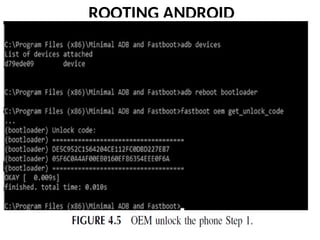










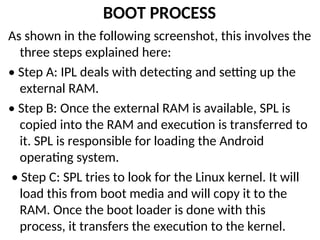

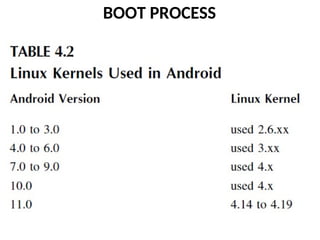









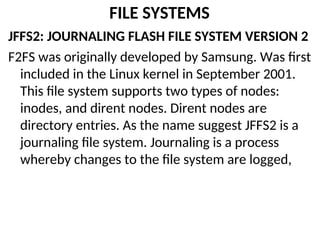


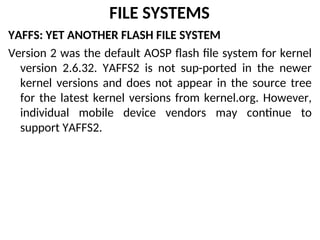






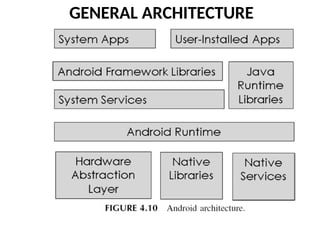








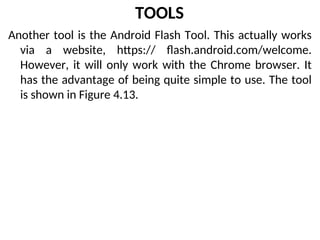









































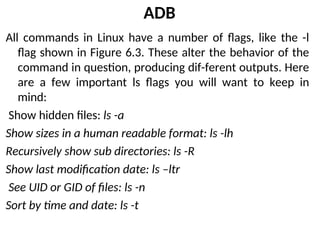












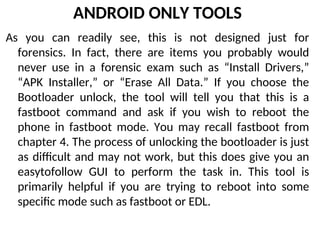






























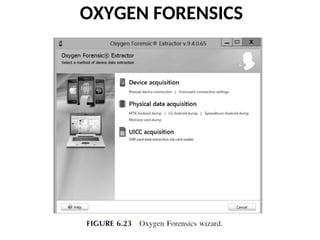














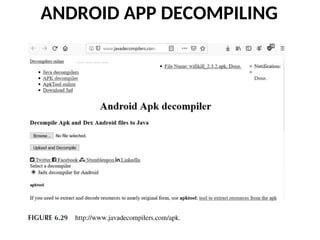























































![[HIFLUX] Lok Fitting&Valve Catalog 2025 (Eng)](https://cdn.slidesharecdn.com/ss_thumbnails/lokfittingen-250528072439-8696f1c6-thumbnail.jpg?width=560&fit=bounds)












